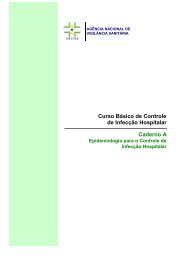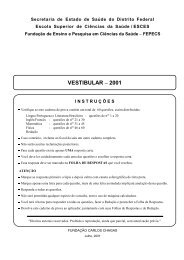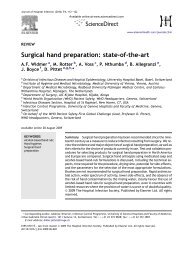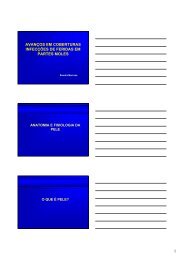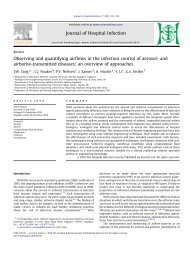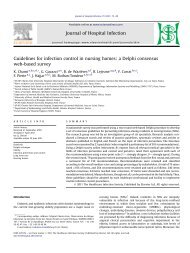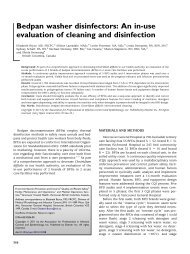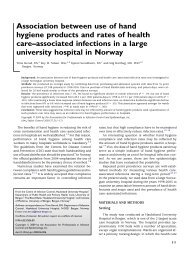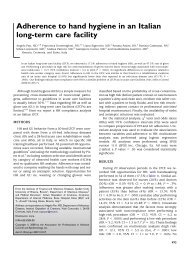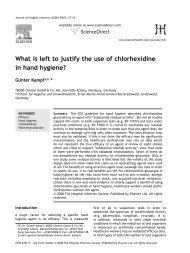Dental unit waterlines: source of contamination and cross ... - CCIH
Dental unit waterlines: source of contamination and cross ... - CCIH
Dental unit waterlines: source of contamination and cross ... - CCIH
You also want an ePaper? Increase the reach of your titles
YUMPU automatically turns print PDFs into web optimized ePapers that Google loves.
102 S. Kumar et al.<br />
following manual manipulation <strong>of</strong> independent reservoir<br />
bottles by staff with poor h<strong>and</strong> hygiene. Reliance<br />
solely on the aerobic count in DUWL as an indicator <strong>of</strong><br />
the associated health risks may underestimate the<br />
risk, as aerobic counts will not highlight the presence<br />
<strong>of</strong> respiratory <strong>and</strong> opportunistic pathogens. Isolation<br />
<strong>of</strong> the latter organisms in water intended for irrigation<br />
<strong>of</strong> a medical device such as a dental h<strong>and</strong>piece may<br />
constitute both an infection control risk <strong>and</strong> health<br />
hazard. 21 DUWL contaminated with 30% <strong>of</strong> opportunistic<br />
pathogens such as Pseudomonas spp. or Legionella<br />
spp. are likely to constitute a greater health risk<br />
to staff <strong>and</strong> patients than DUWL with a high bacterial<br />
count <strong>of</strong> millions <strong>of</strong> organisms per/mL in the absence<br />
<strong>of</strong> known pathogens. An alternative approach for risk<br />
assessment <strong>and</strong> management is to use epidemiological<br />
<strong>and</strong> serological techniques to screen for evidence<br />
<strong>of</strong> DUWL-associated infection in both the dental team<br />
<strong>and</strong> dental patients.<br />
What are the risks to patients?<br />
There is no evidence <strong>of</strong> a widespread public health<br />
problem from exposure to DUW. Nevertheless, the<br />
goal <strong>of</strong> infection control is to minimise the risk<br />
from exposure to potential pathogens <strong>and</strong> to<br />
create a safe working environment in which to<br />
treat patients. The ever-increasing number <strong>of</strong><br />
patients who are either immunocompromised or<br />
immunosuppressed due to drug therapy, alcohol<br />
abuse or systemic disease has produced a cohort <strong>of</strong><br />
patients susceptible to environmental waterborne<br />
opportunistic pathogens such as those prevailing in<br />
DUW. The organisms recovered from DUW vary<br />
with geographic location. They include fungi, freeliving<br />
amoebae, protozoa <strong>and</strong> nematodes as well<br />
as the consistently reported recovery <strong>of</strong> saprophytic<br />
<strong>and</strong> opportunistic Gram-negative pathogens<br />
such as Pseudomonas spp., Klebsiella spp. <strong>and</strong> Flavobacterium<br />
spp.. 22 Of particular concern are the<br />
primary respiratory environmental pathogens<br />
found in DUW that can cause pneumonia, milder<br />
flu-like respiratory infection <strong>and</strong>, less commonly,<br />
wound infections, e.g. Legionella pneumophila<br />
<strong>and</strong> non-pneumophila Legionella spp. as well as<br />
Mycobacterium spp. including Mycobacterium<br />
avium-intracellulare. Mycobacterium avium-intracellulare<br />
can cause disseminated infection in<br />
HIV-seropositive patients following ingestion <strong>and</strong><br />
colonisation <strong>of</strong> the gut. 23,24 Numbers <strong>of</strong> non-tuberculous<br />
mycobacterium (NTM) in DUW exceeded<br />
that <strong>of</strong> drinking water by a factor <strong>of</strong> 400. 25 High<br />
numbers <strong>of</strong> non-tuberculous mycobacteria may<br />
be swallowed, inhaled or inoculated into oral<br />
wounds during dental treatment with the potential<br />
for colonisation, infection or immunisation. Priming<br />
<strong>of</strong> the immune system by exposure to environmental<br />
NTM helps to maintain the anti-tuberculin<br />
immune response. 26 The true extent <strong>of</strong> the risk<br />
posed by NTM in DUW to the immunocompromised<br />
patient has yet to be fully elucidated. Similarly,<br />
the primary pathogen acanthamoeba is recovered<br />
from DUW <strong>and</strong> bi<strong>of</strong>ilm. 22 These organisms are<br />
reputed to cause amoebic keratitis in contact<br />
lens wearers who clean their lenses in tap water. 27<br />
It is unknown whether they present a risk in the<br />
dental setting, but routine use <strong>of</strong> protective eye<br />
wear by both the dental team <strong>and</strong> patients should<br />
shield the eyes from any possible exposure.<br />
Pseudomonas aeruginosa<br />
This can be highly resistant to biocides, including<br />
antibiotics, <strong>and</strong> can grow in dilute disinfectants<br />
such as chlorhexidine <strong>and</strong> iodophors. It is able to<br />
thrive in low nutrient environments such as distilled<br />
water, which is <strong>of</strong>ten used by dentists in<br />
bottled-water systems.<br />
The infective dose for colonisation in healthy<br />
human volunteers is >1.5 10 6 cfu/mL. 28 Such high<br />
concentrations are rarely encountered in DUWs. 29<br />
Antibiotic treatment makes patients more susceptible<br />
to opportunistic pathogens <strong>and</strong> markedly<br />
lowers the required infectious dose. The estimated<br />
risk <strong>of</strong> colonisation by daily exposure to water with<br />
low levels <strong>of</strong> Pseudomonas aeruginosa is 1.7 10 8 .<br />
Therefore, the risk <strong>of</strong> a healthy person becoming<br />
colonised is vanishingly low. 29 The only proven evidence<br />
was published in 1987. 30 Two patients with<br />
solid tumours were unwittingly exposed to DUWs<br />
contaminated with P. aeruginosa. Both patients<br />
subsequently developed gingival abscesses which,<br />
as later confirmed, were caused by the same strain<br />
<strong>of</strong> P. aeruginosa as that isolated from the turbine<br />
<strong>waterlines</strong>. In a prospective study, other non-compromised<br />
patients treated in one <strong>of</strong> six P. aeruginosa-contaminated<br />
dental <strong>unit</strong>s were transiently<br />
colonised for three to five weeks with P. aeruginosa,<br />
but no infection ensued. 30 (It should be noted<br />
that transient colonisation commonly occurs e for<br />
instance, after eating a salad e without any<br />
adverse health consequences.)<br />
Non-tuberculous Mycobacteria spp. (NTM)<br />
These are opportunistic pathogens causing pneumonia,<br />
cutaneous <strong>and</strong> disseminated disease. There<br />
is little evidence for person-to-person transmission<br />
<strong>and</strong> the organisms are transmitted from environmental<br />
<strong>source</strong>s by ingestion, inoculation or inhalation.<br />
Worldwide, there is an increasing



